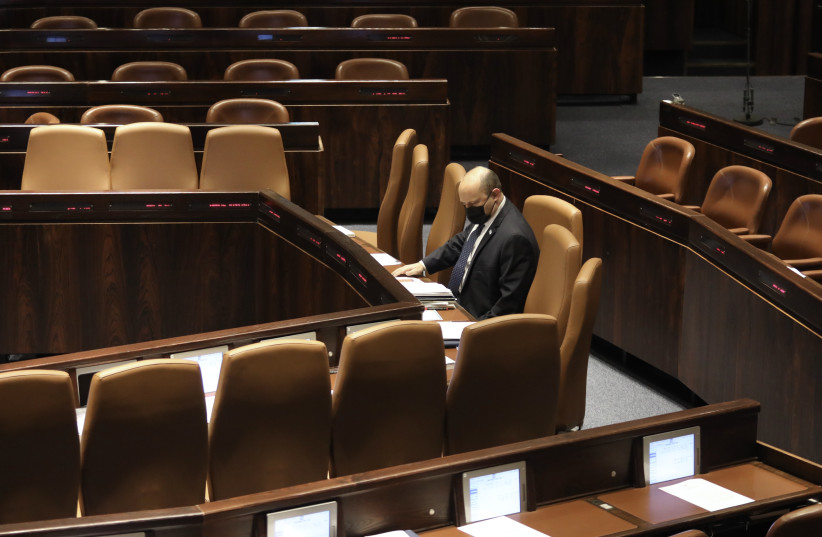Israeli public life has undergone dramatic changes over the last few years.
In the past, certain groups would stand up against others. The red against the blue. Belonging to a certain group meant that you accepted their platform and voted along party lines. This was referred to as identity politics and voting was a positive action that party members followed as a way to express their solidarity with their team. How each person voted was an expression of personal identity, more than a symbol of support of one political party or camp over another.
We’ve gotten comfortable with the classical way people identify either with the right-wing or left-wing camp, Likud or Labor, a religious or secular party. Each person accepts upon themselves the values of the individual they voted for. This, however, is no longer the way things work.
A new era has begun, which can be explained using the Pyramid Principle for controversies.
This pyramid comprises three controversies that currently divide Israeli society, according to the following priorities:


Pro-Bibi vs Anti-Bibi
Traditional vs Liberal
Rightists vs Leftists
What characterizes this controversy pyramid is a new dynamic in which people no longer define themselves depending on their opinions, the groups they identify with, but instead according to the controversy pyramid.
This is not a positive action, but a negative one. The bottom controversy in the pyramid swallows up the smaller middle one, as well as the even smaller one on top, too. The controversy concerning Netanyahu takes precedence over the controversy dealing with the traditional/liberal question, and they both take precedence over the Right/Left controversy.
As would be expected, the classic Right vs Left paradigm has been pushed to the margins. Some people might maintain that Israeli society as a whole has shifted to the Right in recent years due to the unrelenting waves of terrorism.
Some people define themselves as being passively right-wing, saying that goes along with being a patriotic citizen, and yet the division of people into the categories of Left vs Right no longer characterizes Israeli society, and so it has been removed to the most marginal part of the controversy pyramid.
The classic religious vs secular discourse has also been pushed aside, especially considering that many people place themselves at various spots along the religious/secular spectrum. In both the Sephardi and Ashkenazi communities, there are many who consider themselves traditional. Some haredim are more modern, whereas others are more fundamentalist.
The controversy pyramid has registered all of these changes. In fact, it’s not at all surprising that the current Knesset coalition is made up of liberal religious and secular Jews, with no haredim or traditional secular members.
This controversy pyramid has resulted in an unprecedented situation: A coalition of Netanyahu opponents that is made up of people who come from both the Left and Right, religious and secular Jews, Arabs and Jews. In fact, the only thing everyone has in common is that they are anti-Netanyahu. The controversy pyramid has officially shaped our country.
Instead of supporting agendas, the controversy pyramid allows Israelis to oppose rival agendas together with other people with whom and support the idea of a Greater Israel, I can still be a partner of someone who opposes Netanyahu and supports giving up parts of Israel. If I consider myself a liberal who supports conversion reform, I can still be a partner of someone who thinks that there should be budgeting for families of terrorists.
Moreover, people on the economic right (capitalists) and left (socialists) can find themselves together in this pyramid, so long as they share a similar view vis-à-vis the Netanyahu issue, since in the new pyramid structure, the Bibi question trumps all other statuses.
The unraveling of the Israeli government’s coalition reflects the existence of this new pyramid. Recently, Idit Silman abruptly resigned, depriving the coalition of its slim majority, claiming that it violated Judaism’s values. She didn’t resign as a result of a Left vs Right issue, which is no longer considered sufficient cause to break up the new order.
The controversy pyramid might be temporary, but this is the model that has been in control of operations for the last four election campaigns. It could fall apart after a plea bargain, but it’s possible that it is strong enough to remain intact.
What we do know by now, is that we can no longer deny its existence.
The writer is an international strategic adviser and campaign manager to political leaders around the world, as well as a former adviser to Prime Ministers Naftali Bennett and Benjamin Netanyahu.
Translated by Hannah Hochner.
